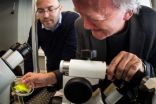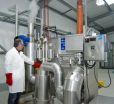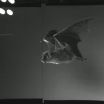(Press-News.org) DALLAS – May 23, 2014 – A microRNA cluster believed to be important for suppressing colon cancer has been found to play a critical role in wound healing in the intestine, UT Southwestern cancer researchers have found.
The findings, first discovered in mice and later reproduced in human cells, could provide a fresh avenue for investigating chronic digestive diseases and for potentially repairing damage in these and other disease or injury settings.
"We identified a novel role for microRNAs in regulating wound healing in the intestine. This finding has important implications for diseases such as ulcerative colitis and Crohn's disease and may be relevant to wound healing mechanisms in other tissues," said Dr. Joshua Mendell, CPRIT Scholar in Cancer Research, Professor of Molecular Biology, and member of the UT Southwestern Harold C. Simmons Cancer Center.
Ulcerative colitis and Crohn's disease — the two most common inflammatory bowel diseases affecting an estimated 1.5 million in the U.S. — stem from an abnormal immune response, which results in the body mistakenly attacking cells in the intestine. The resulting chronic injury to the colon also is considered a risk factor for colon cancer. Understanding the cellular pathways involved could eventually lead to potential therapeutic treatments.
MicroRNAs serve as brakes that help regulate how much of a protein is made, which, in turn, determines how cells respond to various stimuli. Approximately 500 to 1000 microRNAs are encoded in the genomes of mammals. Dr. Mendell's laboratory studies how these tiny regulators work normally and how diseases such as cancer arise when they function in an abnormal manner.
These latest findings, which appear in the journal Cell, focus on two microRNAs: miR-143 and miR-145. While there is extensive literature implicating these microRNAs in colon cancer, little is known about their natural function in the colon. So Dr. Guanglu Shi, postdoctoral researcher in Molecular Biology, and other researchers began their five-year investigation by removing or "knocking out" the gene that produces these two microRNAs in mouse models.
The researchers found that the cells that normally increase their growth to make repairs, called epithelial cells, fail under stress in the knockout animals. Epithelial cells line the intestines where food is digested, separating the contents from the rest of the body and absorbing needed nutrients.
"The epithelial cells of the colon normally proliferate quickly to fill in the wounds from an injury. Without these microRNAs, the epithelial cells are unable to switch into this repair mode, so they never heal the wounds and the mice are not able to survive," Dr. Shi said.
In addition, the research upended traditional thinking about where the tiny microRNAs reside, discovering to everyone's surprise that they reside in supporting cells, called mesenchymal cells, instead of the epithelial cells themselves as previously thought.
"This was surprising because colon cancers derive from the epithelial cells, so it was assumed that the microRNAs must function within them," Dr. Mendell said. "If these microRNAs do participate in colon cancer, they must do so by acting from outside the epithelium."
Identifying the accurate location of the microRNAs is essential to locating the pathways they regulate and eventually, to determining whether they can be manipulated for therapeutic purposes.
Dr. Mendell's team collaborated with a group of surgeons at UT Southwestern including Dr. Joselin Anandam, Assistant Professor of Surgery, Dr. Abier Abdelnaby, Assistant Professor of Surgery, Dr. Glen Balch, Assistant Professor of Surgery, and Dr. John Mansour, Assistant Professor of Surgery, and Dr. Adam Yopp, Assistant Professor of Surgery, who provided human tissue specimens. "The ability to work closely with an outstanding clinical team enabled us to confirm that our findings in mice extend to humans," Dr. Mendell said.
In addition, the researchers say they have worked out one of the many pathways regulated by these microRNAs, called the insulin-like growth factor signaling pathway.
"This pathway is involved in many different processes in the body, but one function is to stimulate wound healing responses," Dr. Mendell explained. "Increasing the amount of insulin-like growth factor signaling improves wound healing in the intestine."
Knocking out miR-143 and miR-145 counteracts that effect.
INFORMATION:
Other researchers involved include Dr. Raghu Chivukula, a former M.D.-Ph.D. student at UT Southwestern.
UT Southwestern's Harold C. Simmons Cancer Center is the only National Cancer Institute-designated cancer center in North Texas and one of just 66 NCI-designated cancer centers in the nation. It includes 13 major cancer care programs with a focus on treating the whole patient with innovative treatments, while fostering groundbreaking basic research that has the potential to improve patient care and prevention of cancer worldwide. In addition, the Center's education and training programs support and develop the next generation of cancer researchers and clinicians.
About UT Southwestern Medical Center
UT Southwestern, one of the premier academic medical centers in the nation, integrates pioneering biomedical research with exceptional clinical care and education. The institution's faculty includes many distinguished members, including six who have been awarded Nobel Prizes since 1985. Numbering more than 2,700, the faculty is responsible for groundbreaking medical advances and is committed to translating science-driven research quickly to new clinical treatments. UT Southwestern physicians provide medical care in 40 specialties to nearly 91,000 hospitalized patients and oversee more than 2 million outpatient visits a year.
Wound-healing role for microRNAs in colon offer new insight to inflammatory bowel diseases
2014-05-23
ELSE PRESS RELEASES FROM THIS DATE:
Failed dwarf galaxy survives galactic collision thanks to full dark-matter jacket
2014-05-23
Like a bullet wrapped in a full metal jacket, a high-velocity hydrogen cloud hurtling toward the Milky Way appears to be encased in a shell of dark matter, according to a new analysis of data from the National Science Foundation's Robert C. Byrd Green Bank Telescope (GBT). Astronomers believe that without this protective shell, the high-velocity cloud (HVC) known as the Smith Cloud would have disintegrated long ago when it first collided with the disk of our Galaxy.
If confirmed by further observations, a halo of dark matter could mean that the Smith Cloud is actually ...
Slide Fire update May 23, 2014
2014-05-23
The Slide Fire is located in Oak Creek Canyon just north of Slide Rock State Park and burning northward, up the canyon into places such as West Fork and Harding Point. Currently it has burned 7,500 acres and is 5% contained. The fire originated just about 4 to 5 miles north of Sedona, just north of Slide Rock State Park on May 20, and was human caused. Investigations regarding the cause are ongoing.
Crews made good progress overnight conducting burnout operations along the north and east flanks of the fire. Several small spot fires were contained through the evening ...
Personal judgments are swayed by group opinion, but only for 3 days
2014-05-23
We all want to feel like we're free-thinking individuals, but there's nothing like the power of social pressure to sway an opinion. New research suggests that people do change their own personal judgments so that they fall in line with the group norm, but the change only seems to last about 3 days. The research is published in Psychological Science, a journal of the Association for Psychological Science.
This is a photo of a figure standing out from the crowd."Our findings suggest that exposure to others' opinions does indeed change our own private opinions — but it doesn't ...
Social marketing at the movies
2014-05-23
Word-of-mouth marketing is recognized as a powerful route from long-tail sales to blockbuster, whether one is talking about the latest fishy ice cream flavor or a Hollywood romantic comedy. In the age of social media and online networking sites, such as Twitter and Facebook, the potential for spreading the word could mean the difference between consumers seeing a product as the best thing since sliced bread or the most rotten of tomatoes.
Chong Oh, Assistant Professor of Computer Information Systems at Eastern Michigan University, in Ypsilanti, Michigan, USA, has analyzed ...
A new way to make sheets of graphene
2014-05-23
CAMBRIDGE, Mass-- Graphene's promise as a material for new kinds of electronic devices, among other uses, has led researchers around the world to study the material in search of new applications. But one of the biggest limitations to wider use of the strong, lightweight, highly conductive material has been the hurdle of fabrication on an industrial scale.
Initial work with the carbon material, which forms an atomic-scale mesh and is just a single atom thick, has relied on the use of tiny flakes, typically obtained by quickly removing a piece of sticky tape from a block ...
Breakthrough method for making Janus or patchy capsules
2014-05-23
Hollow capsules that have a selectively permeable shell are promising candidates as tiny containers for molecules, particles or bubbles, and are becoming increasingly important in a wide variety of applications. But making these kinds of capsules with more than one kind of substance on their shells has been challenging – until now.
In a article in the latest edition of Nature Communications, NTNU researcher Jon Otto Fossum and Paul Dommersnes from the University of Paris, Diderot, were part of a team that showed that both Janus and more advanced patchy capsules can ...
Straw from oilseed as a new source of biofuels
2014-05-23
The bright yellow fields of oilseed rape are a familiar sight at this time of year, but for scientists what lies beneath is just as exciting.
Researchers at the Institute of Food Research are looking at how to turn straw from oilseed rape into biofuel. Preliminary findings are pointing at ways the process could be made more efficient, as well as how the straw itself could be improved.
Straw from crops such as wheat, barley, oats and oilseed rape is seen as a potential source of biomass for second generation biofuel production. Currently the UK produces around 12 million ...
Tiny muscles help bats fine-tune flight, stiffen wing skin
2014-05-23
VIDEO:
As bats fly the air pushes their compliant skin around. A new study provides evidence that they control wing stiffness and shape using muscles embedded in their skin.
Click here for more information.
PROVIDENCE, R.I. [Brown University] — A new study of bats reveals a capability within their wondrous wings that may help them fine-tune their flight.
Bats employ a network of nearly hair-thin muscles embedded in the membrane of their inherently floppy wing skin to adjust ...
NASA sees first tropical depression of Eastern Pacific hurricane season
2014-05-23
One week after the official start of hurricane season in the Eastern Pacific Ocean, the first tropical depression was born hundreds of miles southwest of Mexico. NASA's TRMM satellite and NOAA's GOES-West satellites provided looks inside and outside of the depression's clouds. Hurricane season in the Eastern Pacific began officially on May 15.
On May 21 at 22:59 UTC (6:59 p.m. EDT) the Tropical Rainfall Measuring Mission (TRMM) satellite passed over System 92E, which was what Tropical Depression 1E (TD1E) was called before it organized into a depression. TRMM's Precipitation ...
Supernova caught in the act by palomar transient factory
2014-05-23
Supernovae—stellar explosions—are incredibly energetic, dynamic events. It is easy to imagine that they are uncommon, but the universe is a big place and supernovae are actually fairly routine. The problem with observing supernovae is knowing just when and where one is occurring and being able to point a world-class telescope at it in the hours immediately afterward, when precious data about the supernova's progenitor star is available. Fortunately the intermediate Palomar Transient Factory (iPTF) operated by Caltech scans the sky constantly in search of dramatic astrophysical ...






